So, the wait finally ended! After a bit of a delay, Sandman Overture #2 was released into the world. I have many thoughts on it, so first I’ll just say that I think this issue is A) beautiful, and B) a potentially extraordinary addition to the Sandman series. There’s still more throat-clearing here than I wanted, but I’m starting to feel like we’re rolling into a real story. Hopefully I’m right?
From here on down the recap will be full of details and spoilers, so go read the issue before you continue!
Plotty things:
First, there are a lot of Dreams here, so I’ll refer to the pale fellow with the hair that we all know as the main character of Sandman as Morpheus, and then try to sketch out the other aspects of Dream in the least confusing way possible.
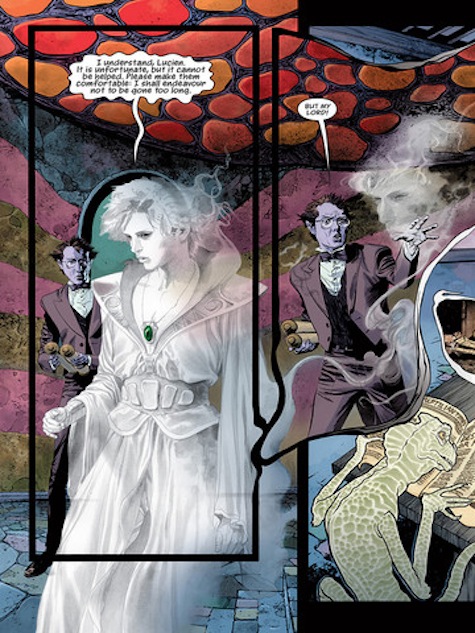
We check in with Daniel/Dream, who stands up a delegation to go into Mad Hettie’s dreams. Hettie, who is now 272 years old, recounts some backstory we didn’t know before. She takes Daniel into the mental hospital where she spent part of her life, and he finds a watch hidden behind a cabinet. She’s confused by Daniel, because he can’t possibly be the Morpheus she remembers:
“You aren’t him. He’s a snooty bugger. Walks around like he’s got a broomstick up his arse.”
(This becomes the theme of the issue by the way – Morpheus is mocked a few times, and forced to deal with the fact that he can be insufferable. As I read these issues, I’m trying to imagine them gathered into a graphic novel and shelved with the rest of Sandman, and I’m still not sure how I feel about it. Does this teasing work with the Dream we meet in Preludes and Nocturnes? Is this the groundwork that was laid for him to become more empathetic as the series continued?)
The Concatenation of Dream, which Neil now refers to as a convocation, because he has to use all of his 50-cent words, devolves into a multi-page argument between Dream and…. Dream. Seriously, all the dreams start arguing, talking about how they all already know what the others are going to say, and that they’re all the same being. Finally, Morpheus asks himself if he’s always this irritating. (Yes, Morpheus. Yes, you always were. Nada could have told you that back in the ‘90s. And so could Nuala. And Thessaly. And Death. She threw a baguette at you, remember?) All the Dreams (who are just one Dream) turn to the oldest Dream (still the same Dream) for answers.
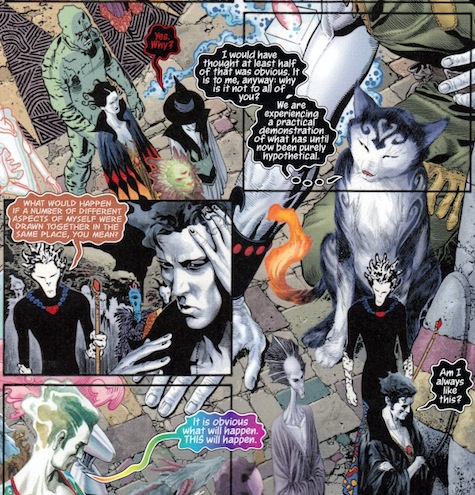
All the (same) Dreams realize that they’ve gathered like this because on of their aspects has been removed from existence, without another one taking up the mantle. Since Morpheus was the last to arrive to the convo-concaten-ation, we’re with his POV. The first created Dream begins to speak, and the second time I looked through I began to wonder—is this the Dream of the Elder Gods? He says he is the Dream of “those that sleep in the space beneath space” and that “they still sleep, in the space beyond space.” Has Gaiman just pocket-universed Sandman and his bit of the DCU into Lovecraft’s Mythos?
The OG Dream tells them that the Universe has lived too long, drops an invisible mic, and disappears. They notice then that each of them is beginning to disappear, and they agree to take the question to “The First Circle.”
Morpheus uses his Ruby to demand an audience with a character named Glory, who seemingly can answer his questions. Their conversation takes place inside the Ruby, as different manifestations of dream ask their questions in different facets. And he repeats what the various Dreams were saying: something is causing a rip in the fabric of reality. A dream has died.
Dream finally cuts to the chase and asks the Big Question: “Why am I here?”
Glory answers: “You are here because a child lived, and world died, a long time ago.” Dream looks shocked.
We cut to a woman, possibly made of starlight? She is bathing and singing while an attendant asks her questions, and she says vague things about “our kind holding grudges.” Her attendant thinks the darkness is coming again, and the bathing woman says that in time, all this will be hers again.
Cut back to Morpheus. He is walking to see someone…and another aspect of himself accompanies him. It is the Dream of Cats, because of course it is! The Dream of Cats walks by himself, and says so, because he’s read Kipling. Adorable. They are going where none of the Endless is allowed to go, and the way is going to be hard. And in the last panel, Dream of Cats asks Morpheus himself, “Do you think Father will be pleased to see us?”
Dun-dun DUNNNNNN.
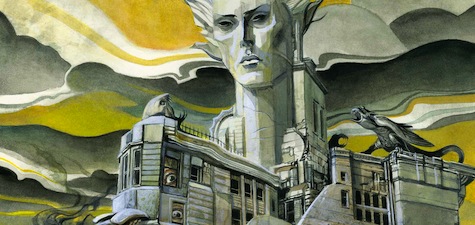
Thoughts:
FATHER???!!!
Who is the bathing woman? She can’t be another Endless, right? Have we met them all? What is her relationship to Morpheus, and how was “all this”—presumably the universe itself—once hers? Could this be the pre-Rose Walker vortex? Is this the one who was allowed to live, and caused all the problems that so weakened Dream before his capture by Roderick Burgess?
How does one apply for a job as her attendant? Do you have to know somebody? I’m guessing you have to know somebody.
What’s the significance of the watch Daniel retrieves from Hettie’s dream asylum? Presumably it will figure into the plot, now that the action of this series seems to be rolling…
So I mentioned Morpheus talking to a character named Glory? He later calls him Shekhinah. The Shekhinah, depending on whom you ask, is part of the Hebrew God, the female aspect of the Hebrew God, or, well, the “glory” or “presence” of God. This is the part of God that appears in Temples, as a pillar of fire leading the Hebrews through the desert, and the cloud on top of Mount Sinai that Moses is called into to receive the Ten Commandments. In some interpretations, “glory” becomes the Holy Spirit in Christianity. Meanwhile, in Islam, “Sakinah” is roughly translated as “peace” or tranquility, became a cloud that protected Muhammed on a few occasions, and possibly inspired the founder of Sufism.
Also, I would like all of you to break out your issue, take a good look at the Glory character, and tell me: is Neil implying that Isaac Asimov is the Shekinah? Cause that looks uncannily like Asimov. It isn’t just me, right?
Now over time Sandman brought in gods from Egypt, Greece, Scandinavia, and plenty of Angels from the Silver City, which was currently running things, and demons and angels from the current Hell, which seemed to house pretty much anyone who believed they belonged there, plus a few who didn’t. And obviously, Gaiman loves running amok in the deep cuts of Jewish lore and Christian Apocrypha.
However, I can’t remember a time when the Dream Lord demanded an audience with an aspect of the Judeo-Christian God…
The art!
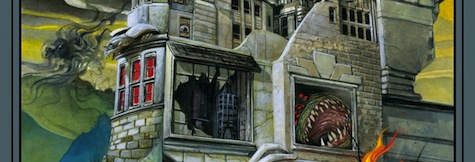
Is gorgeous, as usual. A little bit confusing at first, because J.H. Williams has fun with the panel structure, leading the readers’ eyes around in loop-the-loops, and into Which I really enjoy. Another fun thing is that once again it is packed with detail—the cover features Mad Hettie’s asylum-turned-haunted-dream-house, with different horrors in each window, including eyes, creepy red light, flames, and what appears to be a sarlacc. There’s also a zeppelin caught in the tree out front. Once we dive into the issue it gets even crazier, with asylum walls that are horrifyingly organic, many variations on dream, and the Ruby itself, which goes from being a jewel to feeling more like a living, glowing, entity during the conversation with Glory.
Now, my one actual problem with this issue: Why does Mad Hettie look like a cute 20-something? Is it just because this is her dream, and she dreams herself as still young? Because she announces her age, and every other time we’ve met her she’s looked like an elderly, deeply troubled homeless woman.
All right, that’s all I can think of for the moment—what did you all think? Are you getting excited about this journey we’re on? Do you think the next issue will arrive more or less on time?
Leah Schnelbach is hoping for a Matthew cameo, even though it doesn’t make chronological sense. She just likes Matthew, is all. Tweet words at her!










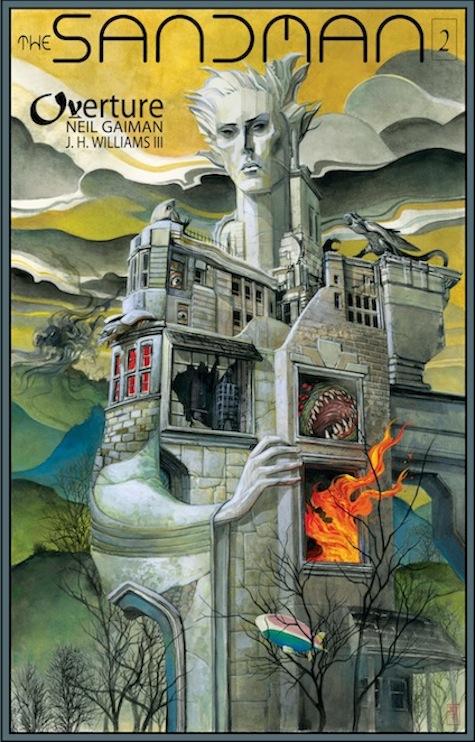
I was struck by JHWIII’s ability to effortlessly reference different artists for the different aspects of Dream.
The Elder Gods Dream seems drawn from late-80s/early-90s Keith Giffen, the Giant Dream recalls Dave Gibbons, the Egyptian Dream reminds me of Moebius—though there’s someone else it reminds me of more that I can’t bring to mind—the Vegetable Dream is perhaps a little Kirbyesqe, others seem to reference Marc Hempel, and other artists whose style I can almost place…truly amazing.
My favorite aspect is the Vorlon version of Dream.
About the possible Lovecraft reference: oh my yes you are correct; that there is a three-lobed burning eye.
In issue #3 of The Books of Magic, Tim Hunter and Rose encounter the warden of the Goblin Market, who is called Glory and who also looks like Isaac Asimov. What connection there is between that Glory and this one is, to say the least, unclear.
The First Circle has been referenced before: in “Brief Lives”, Dream asks Desire to swear by them. “That takes me back,” it says in reply. (But it does.)
In Hesiod’s Theogony, Morpheus is the son of Nyx, the goddess of night. The bathing woman certainly looks like a mother-goddess of night.
I thought this issue was absolutely gorgeous. I can see why it took the extra time, and if it takes five months between issues to bring us art this beautiful then I for one am perfectly willing to wait until December of 2015 for the ending.
At first I thought the Three-Lobed Eye aspect was maybe Ningauble (with six eyes closed) or Sheelba after an eye transplant, but an Elder Gods’ Dream makes more sense. Although it would have been funny if the Elder Gods’ version of Morpheus looked like a cute little bunny or a unicorn or even Delirium’s goldfish….you know, something that would not drive you insane trying to contemplate. Or would that actually make you more insane?
I think the references are clear: Father Time and Mother Night. Chronos and Nyx. Daniel’s references to Time and his search for the watch are connected to Father Time and the past.
I think the goblin market Glory is the same as this one — I think he’s a character out of Jack Vance rather than Asimov.
Well, October rather than December. Still, not a bad prediction.